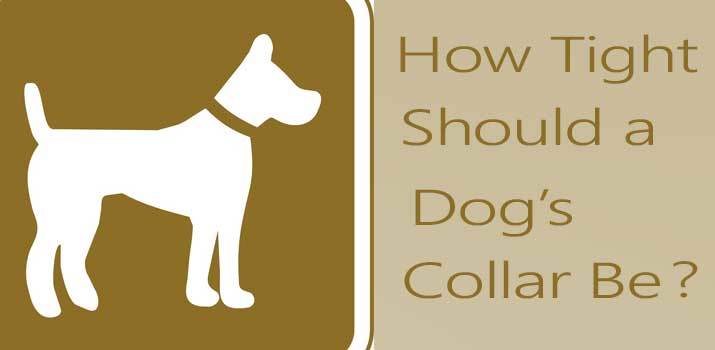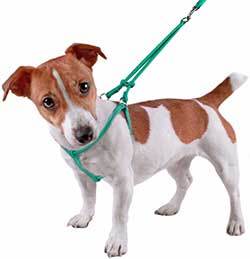Dog collars play an important role in keeping your dog safe. It's something that your pup needs to be wearing every single time they leave your home. Most owners leave them on 24/7 for that added sense of security.
Even the most well-trained dog will have his or her rebellious streak, so it's important to invest in a collar that can keep them contained.
Once you find one that suits your dog's needs and personality, you're going to want to make sure that it fits properly.
Collars are only effective if they fit nicely on your dog's neck.

It's a fine line between making it too loose and too snug. The collar needs to be tight enough to prevent your dog from wriggling their way out, yet loose enough to not cause injuries. While most people don't give their dog's collar a second thought, these accessories can be dangerous.
Injuries from an improperly fitted collar are more common than you think. With that comes an important question. Just how tight should your dog's collar really be?
Finding the Perfect Fit
Before you purchase your collar, you need to take some accurate measurements to ensure that it's suited for your dog. All dogs are different. Even two dogs of the same breed can have different neck measurements due to lifestyle and weight.
Instead of guessing, whip out a tape measure and figure how large your dog's neck is.
To do this, simply wrap a cloth tape measure around their neck. It's a good idea to take a few different measurements at various points on their neck. Typically, the lower part of the neck is going to be the most accurate.
The forces of gravity will cause the collar to slide down the neck until it hits the shoulders. If you don't have a cloth tape measure, you can also use a piece of string or fabric and measure that with a standard ruler.
In addition to measuring the circumference of your dog's neck, you need to consider the thickness. Some breeds, such as Pugs and Bulldogs, have relatively short necks that require thinner collars. If the collar is too thick, it could cause uncomfortable chaffing as your pup walks.
There's no way to measure for width. Just examine your dog and see if they would fair better with a shorter or thicker collar. Generally, thinner collars are more comfortable for small or overweight dogs.
Collars come in a range of sizes to suit all breeds. Many manufacturers use sizing labels like "Small," "Medium," and "Large." Don't take these sizes at face value. Like with human clothing, collar sizes can vary from brand to brand.
Check the exact measurements of the collar and make sure it's larger than what your dog needs. You can always adjust the collar to make it tighter, but you can't add more material to make it looser.
The Two-Finger Trick
Once you have the collar, you can put it on your dog and perform the "Two-Finger" test. Secure the collar around your dog's neck so that it has enough room to move around. It should not, by any means, be pressing into your dog's skin.
Then, slide two fingers behind the collar and against your pup's neck. If the collar feels snug, it's just right. You shouldn't have to force your fingers underneath the collar. If it's difficult to perform this test, the collar is too tight.
Also, it's recommended that you slide the collar up to see if it can slip over your dog's head. Canines with triangular heads, such as a Siberian Husky or Greyhound, are notorious for slipping out of their collars at the most inopportune times.
If the collar can make it past the ears, it needs to be tightened a bit.
An Alternative to Collars
There are many instances in which an owner may want to consider using a harness rather than a collar. Harnesses wrap around your dog's body, providing more security. They can be beneficial for heavy pullers, dogs with fatter necks, or pups who can easily slip out of their collar.
People who own fluffier dogs tend to go with harnesses as well because that extra fur can make collars feel tighter than they really are.

Harnesses offer a lot of benefits over a traditional collar. One of the biggest is that there is no risk for choking.
Even if your dog's collar fits them just right, it can pose a serious choking risk if your dog likes to pull on their lead.
One distracted sprint towards a squirrel can tighten up the collar significantly, leading to a host of problems.
Harnesses don't wrap around the neck at all. Most of the pressure is placed on their chest. The straps wrap around their body, under their legs, and meet on the top of their back.
These accessories can actually help to instill better behavior in your dog as well. When they pull on a harness, that pressure on their chest and body tends to make them stop immediately. If you ever need to contain your dog, harnesses also give you greater control.
More of their body mass is wrapped up in the harness, giving you more leverage to prevent your dog from taking off.
Like with collars, harnesses also need to be fitted properly. However, because the straps don't go around the neck, there's a bit more leeway. They can be tightened a bit more without putting your dog at risk.
If your dogs tend to be on the more relaxed side, you can even loosen the harness up. The various straps will still keep your dog secure if they try to run off. Like with collars, it's a good idea to perform the two-finger trick to make sure that the harness is not too tight.
The Importance of a Proper Fit - Possible Risks
Now that you understand how to secure your dog's collar so that it's comfortable and safe, let's look into some of the issues that can arise if you don't do it correctly.
Despite all of the benefits that collars can provide, they have the potential to do some pretty serious damage to your dog's body and well-being.
Neck Injuries
Neck injuries are a very real risk. These types of injuries often occur when the collar is too tight and the dog suddenly jerks in one direction. Typically, the issues that arise are minor. They may hurt their neck muscles or suddenly cough due to breathing difficulties.
However, if the collar is not loosened, they may experience lasting complications. Your dog could damage the tissue around their neck or hurt various glands. In extreme cases, your dog may experience fracture a bone.
Choking
Have you ever discovered your dog's collar or identification tags caught on something? This issue can be much more than a minor nuisance. Dogs can easily get their collars caught on something as they run and jump.
If that object gets underneath their collar because it's too loose, your dog may end up strangling themselves trying to get free. This risk is even higher when your dog is tied on a leash outside.
Fences, posts, and even tree branches could get caught on the collar as they jump, essentially hanging your dog.
Accidental Mouth and Leg Injuries
Your dog's collar needs to be able to accommodate their everyday activities, such as grooming and scratching. Injuries caused by loose collars are quite common. Dogs can get their mouths stuck on the collar as they're trying to lick themselves, causing them to cut their mouths and break teeth.
If they're scratching, their feet can get stuck. This may result in your dog breaking a limb as they stumble around in an attempt to get free.
Skin Irritation
Skin irritation can be caused by a collar that's too tight, too loose, or too wide. The edges of the collar may not seem like they can do much damage, but the friction they cause can lead to rashes, hair loss, and even cuts.
If you notice any irritation at all, reconsider the collar's fit. You may even need to get a new collar that has a padded interior for comfort.
Conclusion
To sum up, your dog's collar should be loose enough to move freely, but tight enough so that they can't slip out or get parts of their body stuck behind it.
Take accurate measurements of your dog's neck and utilize the two-finger rule to get a better idea of whether or not you need to tighten it. If you're still in doubt, you can switch to a harness or consult with your vet for more guidance.

